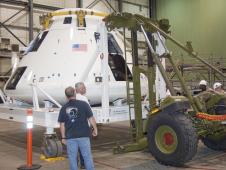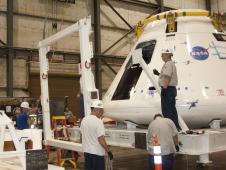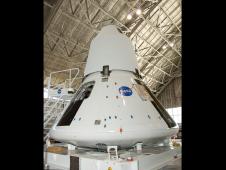 Technicians at NASA Dryden connect one of two mobilizer units to the Orion flight test crew module transportation fixture in preparation for loading the module onto an Air Force C-17 cargo aircraft. EDWARDS, Calif. – The Orion crew module that will be used for the first launch abort system Pad Abort 1 flight test is scheduled to depart NASA’s Dryden Flight Research Center Aug. 19 for the White Sands Missile Range, N.M., where the launch abort tests will be performed.
Technicians at NASA Dryden connect one of two mobilizer units to the Orion flight test crew module transportation fixture in preparation for loading the module onto an Air Force C-17 cargo aircraft. EDWARDS, Calif. – The Orion crew module that will be used for the first launch abort system Pad Abort 1 flight test is scheduled to depart NASA’s Dryden Flight Research Center Aug. 19 for the White Sands Missile Range, N.M., where the launch abort tests will be performed.
Similar to the Apollo crew module, the Orion capsule also has a launch abort system to make it possible for the crew to escape from the launch rocket should something go wrong on the pad or during the ascent to orbit.
At Dryden, engineers and technicians installed instrumentation, electrical wiring, computer systems, avionics, parachutes, thermal ducting, acoustic blankets and a Space Integrated Global Positioning System/Inertial Navigation System.
Numerous tests were conducted on the Orion test capsule while at Dryden. Large-scale test rigs were fabricated to closely measure the weight and center of gravity of the crew module. Vibration and acoustics tests were then completed to assess the effects of an abort motor firing on both the structure and internal electronics of the crew module. Finally, a combined systems test was conducted to verify the flight readiness of the flight control, antenna, pyrotechnic, and ground control systems. That test was also used as a dress rehearsal for mission operations.
 Technicians at NASA Dryden install the “goalpost” fixture to the Orion crew module integration stand. Once at White Sands, the launch abort system and crew module will undergo further combined systems testing, followed by mounting of the launch abort system atop the crew module. The Orion crew module for the Pad Abort 1 test is the same size, shape and weight of the spacecraft that will be used on missions to the International Space Station and beyond. Since there will be no crew on board for the launch abort tests, the crew module will not have seats, life support systems, or other crew equipment.
Technicians at NASA Dryden install the “goalpost” fixture to the Orion crew module integration stand. Once at White Sands, the launch abort system and crew module will undergo further combined systems testing, followed by mounting of the launch abort system atop the crew module. The Orion crew module for the Pad Abort 1 test is the same size, shape and weight of the spacecraft that will be used on missions to the International Space Station and beyond. Since there will be no crew on board for the launch abort tests, the crew module will not have seats, life support systems, or other crew equipment.
Over 600 sensors were installed on the crew module and launch abort systems. These sensors measure pressures, temperatures, accelerations, acoustics, and structural strain. A high-speed video camera was also installed to capture the inflation and dynamics of the three 116-foot recovery parachutes.
The first of five planned abort tests, Pad Abort 1, is scheduled for early 2010 from the new launch pad at White Sands. Two of the tests will evaluate the performance of the launch abort system from ground level, simulating an abort while astronauts are on the pad waiting for launch. Three more tests will evaluate the launch abort system performance at different altitudes and speeds using an excess Peacekeeper rocket, provided by the U.S. Air Force, to carry the crew module to the proper test conditions.
 The Orion flight test crew module that will be used for the Orion Launch Abort System Pad Abort 1 flight test is shown with its adapter cone that attaches the abort system’s rocket motor to the module. For the pad abort test, the launch abort system’s abort motor will be ignited, lifting the Orion crew module test article to an altitude of about one mile, where the launch abort system will jettison itself approximately 22 seconds after the launch. Parachutes will deploy to land the vehicle on the desert floor. NASA has developed additional methods to abort a launch using the Orion service module and the crew module during the high altitude portion of the climb to orbit.
The Orion flight test crew module that will be used for the Orion Launch Abort System Pad Abort 1 flight test is shown with its adapter cone that attaches the abort system’s rocket motor to the module. For the pad abort test, the launch abort system’s abort motor will be ignited, lifting the Orion crew module test article to an altitude of about one mile, where the launch abort system will jettison itself approximately 22 seconds after the launch. Parachutes will deploy to land the vehicle on the desert floor. NASA has developed additional methods to abort a launch using the Orion service module and the crew module during the high altitude portion of the climb to orbit.
The Orion Project Office at NASA’s Johnson Space Center in Houston is leading a government and contractor team to test the spacecraft’s launch abort system. Under Johnson’s direction, NASA’s Dryden Flight Research Center leads the flight test vehicle integration and operations effort at Edwards, Calif.
For more information about NASA’s Constellation Program and Orion Project, visit:
https://www.nasa.gov/constellation
For more about aerospace research at NASA’s Dryden Flight Research Center, visit:
https://www.nasa.gov/centers/dryden
PHOTO EDITORS: High-resolution photos to support this release are available on-line at:
https://www.nasa.gov/centers/dryden/news/newsphotos/index.html
– end –
text-only version of this release
To receive status reports and news releases issued from the Dryden Newsroom electronically, send a blank e-mail message to dfrc-subscribe@newsletters.nasa.gov. To unsubscribe, send a blank e-mail message to dfrc-unsubscribe@newsletters.nasa.gov. The system will confirm your request via e-mail.
Dryden Flight Research Center
P.O. Box 273
Edwards, Calif. 93523
Phone 661-276-3449
FAX 661-276-3566
Leslie Williams
NASA Dryden Flight Research Center
661-276-3893
leslie.a.williams@nasa.gov




























